Zoom Connector for Azure Data Factory (Pipeline)
Zoom Connector can be used to integrate Zoom REST API in your App / BI Tools. You can read/write data about Meetings, Invite, Users, Accounts and more.
In this article you will learn how to quickly and efficiently integrate Zoom data in Azure Data Factory (Pipeline) without coding. We will use high-performance Zoom Connector to easily connect to Zoom and then access the data inside Azure Data Factory (Pipeline).
Let's follow the steps below to see how we can accomplish that!
Zoom Connector for Azure Data Factory (Pipeline) is based on ZappySys API Driver which is part of ODBC PowerPack. It is a collection of high-performance ODBC drivers that enable you to integrate data in SQL Server, SSIS, a programming language, or any other ODBC-compatible application. ODBC PowerPack supports various file formats, sources and destinations, including REST/SOAP API, SFTP/FTP, storage services, and plain files, to mention a few.
Create ODBC Data Source (DSN) based on ZappySys API Driver
Step-by-step instructions
To get data from Zoom using Azure Data Factory (Pipeline) we first need to create a DSN (Data Source) which will access data from Zoom. We will later be able to read data using Azure Data Factory (Pipeline). Perform these steps:
-
Download and install ODBC PowerPack.
-
Open ODBC Data Sources (x64):

-
Create a User data source (User DSN) based on ZappySys API Driver:
ZappySys API Driver
-
Create and use User DSN
if the client application is run under a User Account.
This is an ideal option
in design-time , when developing a solution, e.g. in Visual Studio 2019. Use it for both type of applications - 64-bit and 32-bit. -
Create and use System DSN
if the client application is launched under a System Account, e.g. as a Windows Service.
Usually, this is an ideal option to use
in a production environment . Use ODBC Data Source Administrator (32-bit), instead of 64-bit version, if Windows Service is a 32-bit application.
Azure Data Factory (Pipeline) uses a Service Account, when a solution is deployed to production environment, therefore for production environment you have to create and use a System DSN. -
Create and use User DSN
if the client application is run under a User Account.
This is an ideal option
-
When the Configuration window appears give your data source a name if you haven't done that already, then select "Zoom" from the list of Popular Connectors. If "Zoom" is not present in the list, then click "Search Online" and download it. Then set the path to the location where you downloaded it. Finally, click Continue >> to proceed with configuring the DSN:
ZoomDSNZoom
-
Now it's time to configure the Connection Manager. Select Authentication Type, e.g. Token Authentication. Then select API Base URL (in most cases, the default one is the right one). More info is available in the Authentication section.
Zoom authentication
OAuth App must be created under Admin Console > Channel > API > Settings. [API reference]
Follow the steps below to create a Zoom OAuth app and obtain the required credentials (Client ID and Client Secret):
- Go to the Zoom App Marketplace and sign in with your Zoom account.
- From the top navigation bar, open the Develop dropdown and select Build App.
- In the What kind of app are you creating window, select General App, click the Create button.
- Enter a name for your app and select the app type.
(E.g. Zoom-General App) - Click Create to continue.
- In the Redirect URL for OAuth field, enter the following URI and add it to the allow list:
https://zappysys.com/oauth/ - Copy your Client ID and Client Secret, then paste them into the ZappySys API Component/Driver UI under the required parameters.
- From the Scopes window, please add the appropriate Granular scopes. You can search for the scopes listed below and enable them as needed.
Scope Levels:- User-Level: Grants access only to the authenticated user’s data. Suitable for apps where users connect with their own Zoom account.
- Admin-Level: Grants access to data across all users in the account, provided the user has admin permissions. Best for organization-wide apps.
- Master-Level: Grants access at the highest level, typically for apps that need full account control (including sub-accounts). Requires Master Account credentials.
Recommended Scopes:
User-Level- user:read:settings
- meeting:read:list_meetings
- meeting:read:meeting
- meeting:read:list_registrants
- meeting:read:past_meeting
- meeting:read:list_registration_questions
- webinar:read:list_webinars
- webinar:read:webinar
- webinar:read:list_registrants
- report:read:user
- user:read:settings:admin
- user:write:user:admin
- meeting:read:list_meetings:admin
- meeting:read:meeting:admin
- meeting:read:list_registrants:admin
- meeting:read:past_meeting:admin
- meeting:read:list_registration_questions:admin
- user:read:list_users:admin
- webinar:read:list_webinars:admin
- webinar:read:webinar:admin
- webinar:read:list_registrants:admin
- report:read:user:admin
- user:read:settings:master
- meeting:read:list_meetings:master
- meeting:read:meeting:master
- meeting:read:list_registrants:master
- user:read:list_users:master
- webinar:read:list_webinars:master
- webinar:read:webinar:master
- webinar:read:list_registrants:master
- report:read:user:master
- That’s it! After adding the scopes, click Continue to complete the process.
- In the ZappySys API Component/Driver UI, enter your Zoom app Client ID and Client Secret, then click Generate Token to obtain the access tokens.
- You’re done!
API Connection Manager configuration
Just perform these simple steps to finish authentication configuration:
-
Set Authentication Type to
User Credentials (Access Your Data) [OAuth] - Optional step. Modify API Base URL if needed (in most cases default will work).
- Fill in all the required parameters and set optional parameters if needed.
- Press Generate Token button to generate the tokens.
- Finally, hit OK button:
ZoomDSNZoomUser Credentials (Access Your Data) [OAuth]https://api.zoom.us/v2Required Parameters Client Id Fill-in the parameter... Client Secret Fill-in the parameter... Redirect Url Fill-in the parameter... Token Url Fill-in the parameter... Authorization Url Fill-in the parameter... Optional Parameters Retry Mode RetryWhenStatusCodeMatch Retry Status Code 429 Retry Count Max 5 Retry Multiply Wait Time True 
Zoom authentication
Server-to-Server OAuth authentication method that lets applications access the Zoom API directly without user login or consent, using a Client ID and Secret to generate short-lived tokens. [API reference]
Follow the steps below to create a Zoom OAuth app and obtain the required credentials (Client ID and Client Secret):
- Go to the Zoom App Marketplace and sign in with your Zoom account.
- From the top navigation bar, open the Develop dropdown and select Build App.
- In the What kind of app are you creating window, select Server to Server OAuth App, click the Create button.
- Enter a name for your app and select the app type.
(E.g. Basic OAuth App) - Click Create to continue.
- Copy your Account ID, Client ID, and Client Secret, then paste them into the ZappySys API Component/Driver UI under the required parameters.
- In the Information window, enter the company name, developer name, and email address, then click Continue.
- From the Scopes window, please add the appropriate Granular scopes. You can search for the scopes listed below and enable them as needed.
Scope Levels:- Admin-Level: Grants access to data across all users in the account, provided the user has admin permissions. Best for organization-wide apps.
- Master-Level: Grants access at the highest level, typically for apps that need full account control (including sub-accounts). Requires Master Account credentials.
Recommended Scopes:
Admin-Level- user:read:settings:admin
- user:write:user:admin
- meeting:read:list_meetings:admin
- meeting:read:meeting:admin
- meeting:read:list_registrants:admin
- meeting:read:past_meeting:admin
- meeting:read:list_registration_questions:admin
- user:read:list_users:admin
- webinar:read:list_webinars:admin
- webinar:read:webinar:admin
- webinar:read:list_registrants:admin
- report:read:user:admin
- user:read:settings:master
- meeting:read:list_meetings:master
- meeting:read:meeting:master
- meeting:read:list_registrants:master
- user:read:list_users:master
- webinar:read:list_webinars:master
- webinar:read:webinar:master
- webinar:read:list_registrants:master
- report:read:user:master
- That’s it! After adding the scopes, click Continue to complete the process.
- In the ZappySys API Component/Driver UI, enter your Zoom app Account ID, Client ID, and Client Secret, then click Test Connection.
- You’re done!
API Connection Manager configuration
Just perform these simple steps to finish authentication configuration:
-
Set Authentication Type to
App Credentials (Access Account Level Data) [OAuth] - Optional step. Modify API Base URL if needed (in most cases default will work).
- Fill in all the required parameters and set optional parameters if needed.
- Finally, hit OK button:
ZoomDSNZoomApp Credentials (Access Account Level Data) [OAuth]https://api.zoom.us/v2Required Parameters Account Id Fill-in the parameter... Client Id Fill-in the parameter... Client Secret Fill-in the parameter... Token Url Fill-in the parameter... Optional Parameters Retry Mode RetryWhenStatusCodeMatch Retry Status Code 429 Retry Count Max 5 Retry Multiply Wait Time True 
Zoom authentication
OAuth App must be created under Admin Console > Channel > API > Settings. [API reference]
Perform the following steps to get the Zoom OAuth credentials (i.e. Client ID and Client Secret)
- Go to Zoom Marketplace Portal and sign in there.
- Once you successfully login then select "Build App" option from Develop dropdown from top left on the page.
- Click on Create button of OAuth panel section of page.
- Enter the name for your application and choose app type (Recommneded "Account-Level App") option for your API
- Then proceed with clicking Create button.
- In Redirect URL for OAuth enter this https://zappysys.com/oauth/ as Redirect URI and add it to allow lists.
- Copy Client ID and Client Secret here and paste it into Connection Manager Required Paramters section in respective place holders
- Add appropiate scopes from the Scopes menu option to the right side of page for your API as below :
NOTE: If you need to read/write data for all users (not just 'me') then add
:adminsuffix in the scope (e.g.meeting:read:admin)- meeting:read
- meeting:write
- user:read
- user:write
- user_info:read
- meeting:read
- chat_channel:read
- chat_channel:write
- chat_contact:read
- chat_message:read
- chat_message:write
- contact:read
- pac:read
- pac:write
- phone:read
- phone:write
- phone_call_control:read
- phone_call_control:write
- phone_call_log:read
- phone_call_log:write
- phone_e911:read
- phone_recording:read
- phone_recording:write
- phone_sms:read
- phone_sms:write
- phone_voicemail:read
- phone_voicemail:write
- recording:read
- recording:write
- tsp:read
- tsp:write
- user:read
- user:write
- user_info:read
- user_zak:read
- webinar:read
- webinar:write
- report:read:user
- Click Generate Token button on Connection Manager UI to generate tokens.
- That's it!
API Connection Manager configuration
Just perform these simple steps to finish authentication configuration:
-
Set Authentication Type to
User Credentials (Access Your Data) - With Legacy Scopes [OAuth] - Optional step. Modify API Base URL if needed (in most cases default will work).
- Fill in all the required parameters and set optional parameters if needed.
- Press Generate Token button to generate the tokens.
- Finally, hit OK button:
ZoomDSNZoomUser Credentials (Access Your Data) - With Legacy Scopes [OAuth]https://api.zoom.us/v2Required Parameters ClientId Fill-in the parameter... ClientSecret Fill-in the parameter... RedirectUrl Fill-in the parameter... TokenUrl Fill-in the parameter... AuthorizationUrl Fill-in the parameter... Optional Parameters Scope RetryMode RetryWhenStatusCodeMatch RetryStatusCodeList 429 RetryCountMax 5 RetryMultiplyWaitTime True 
-
Once the data source connection has been configured, it's time to configure the SQL query. Select the Preview tab and then click Query Builder button to configure the SQL query:
 ZappySys API Driver - ZoomZoom Connector can be used to integrate Zoom REST API in your App / BI Tools. You can read/write data about Meetings, Invite, Users, Accounts and more.ZoomDSN
ZappySys API Driver - ZoomZoom Connector can be used to integrate Zoom REST API in your App / BI Tools. You can read/write data about Meetings, Invite, Users, Accounts and more.ZoomDSN
-
Start by selecting the Table or Endpoint you are interested in and then configure the parameters. This will generate a query that we will use in Azure Data Factory (Pipeline) to retrieve data from Zoom. Hit OK button to use this query in the next step.
SELECT * FROM Meetings WITH( UserId ='me' -- enter user id or email ) --You can get UserId by selecting from 'list_users' endpoint and also this value available as dropdown value for UserId parameter. Some parameters configured in this window will be passed to the Zoom API, e.g. filtering parameters. It means that filtering will be done on the server side (instead of the client side), enabling you to get only the meaningful data
Some parameters configured in this window will be passed to the Zoom API, e.g. filtering parameters. It means that filtering will be done on the server side (instead of the client side), enabling you to get only the meaningful datamuch faster . -
Now hit Preview Data button to preview the data using the generated SQL query. If you are satisfied with the result, use this query in Azure Data Factory (Pipeline):
 ZappySys API Driver - ZoomZoom Connector can be used to integrate Zoom REST API in your App / BI Tools. You can read/write data about Meetings, Invite, Users, Accounts and more.ZoomDSN
ZappySys API Driver - ZoomZoom Connector can be used to integrate Zoom REST API in your App / BI Tools. You can read/write data about Meetings, Invite, Users, Accounts and more.ZoomDSNSELECT * FROM Meetings WITH( UserId ='me' -- enter user id or email ) --You can get UserId by selecting from 'list_users' endpoint and also this value available as dropdown value for UserId parameter. You can also access data quickly from the tables dropdown by selecting <Select table>.A
You can also access data quickly from the tables dropdown by selecting <Select table>.AWHEREclause,LIMITkeyword will be performed on the client side, meaning that thewhole result set will be retrieved from the Zoom API first, and only then the filtering will be applied to the data. If possible, it is recommended to use parameters in Query Builder to filter the data on the server side (in Zoom servers). -
Click OK to finish creating the data source.
Video Tutorial
Read data in Azure Data Factory (ADF) from ODBC datasource (Zoom)
-
Sign in to Azure Portal
-
Open your browser and go to: https://portal.azure.com
-
Enter your Azure credentials and complete MFA if required.
-
After login, go to Data factories.
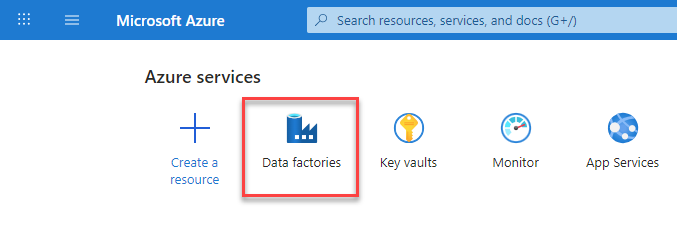
-
-
Under Azure Data Factory Resource - Create or select the Data Factory you want to work with.
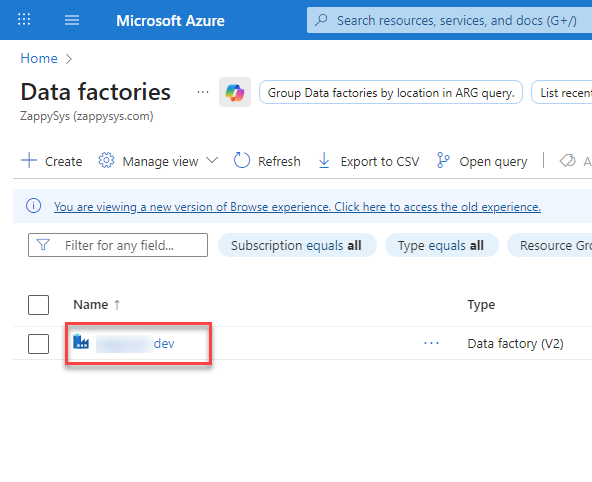
-
Inside the Data Factory resource page, click Launch studio.
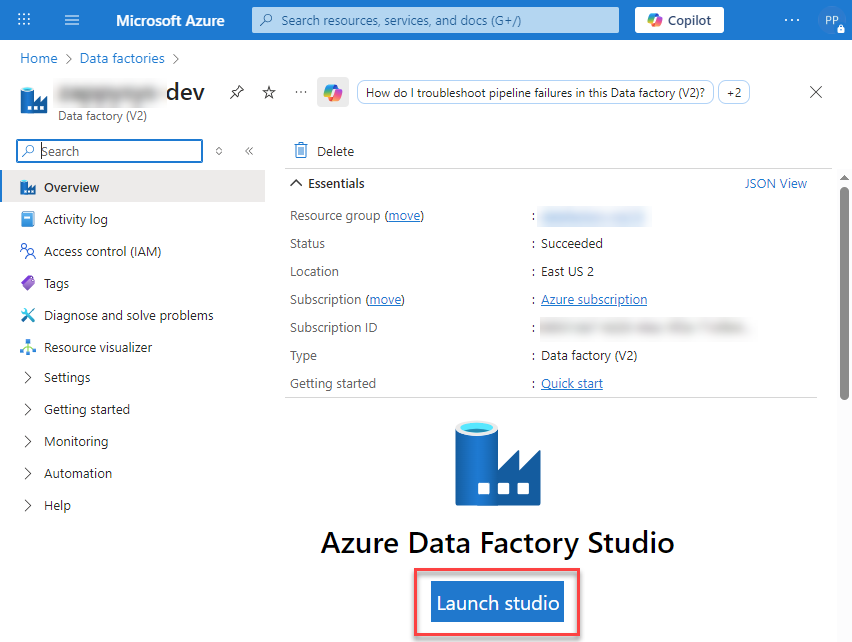
-
Create a New Integration Runtime (Self-Hosted):
In Azure Data Factory Studio, go to the Manage section (left menu).
Under Connections, select Integration runtimes.
Click + New to create a new integration runtime.

-
Select Azure, Self-Hosted option:
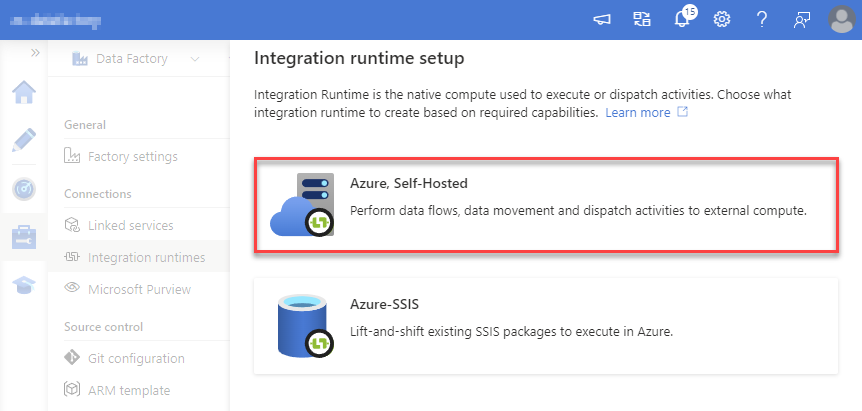
-
Select Self-Hosted option:
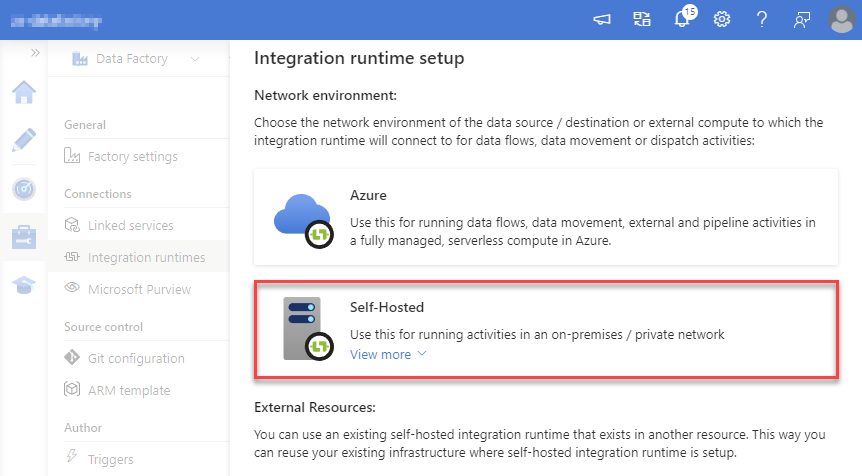
-
Set a name, we will use OnPremisesRuntime:
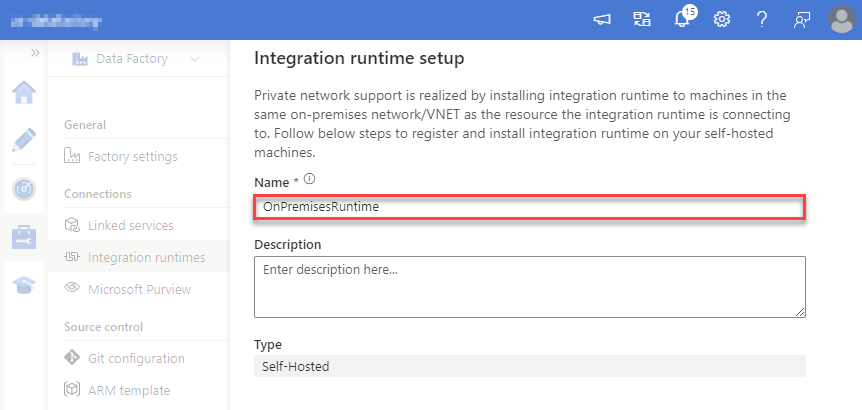
-
Download and install Microsoft Integration Runtime.
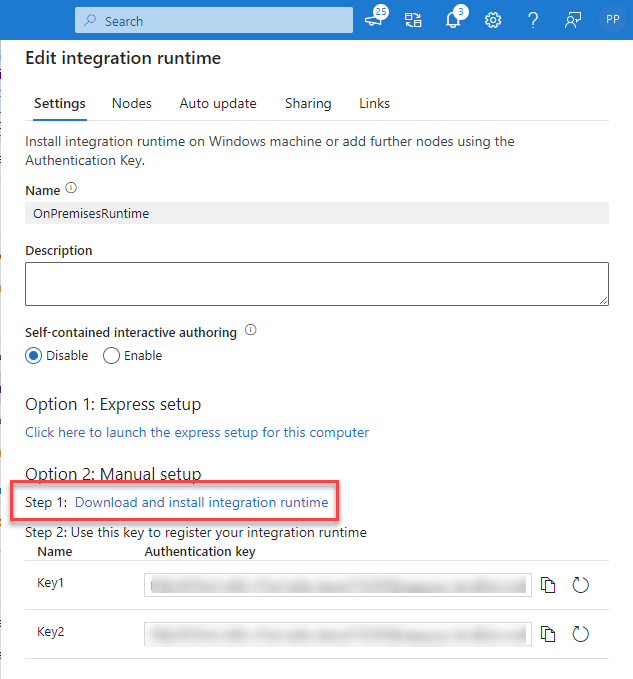
-
Launch Integration Runtime and copy/paste Authentication Key from Integration Runtime configuration in Azure Portal:
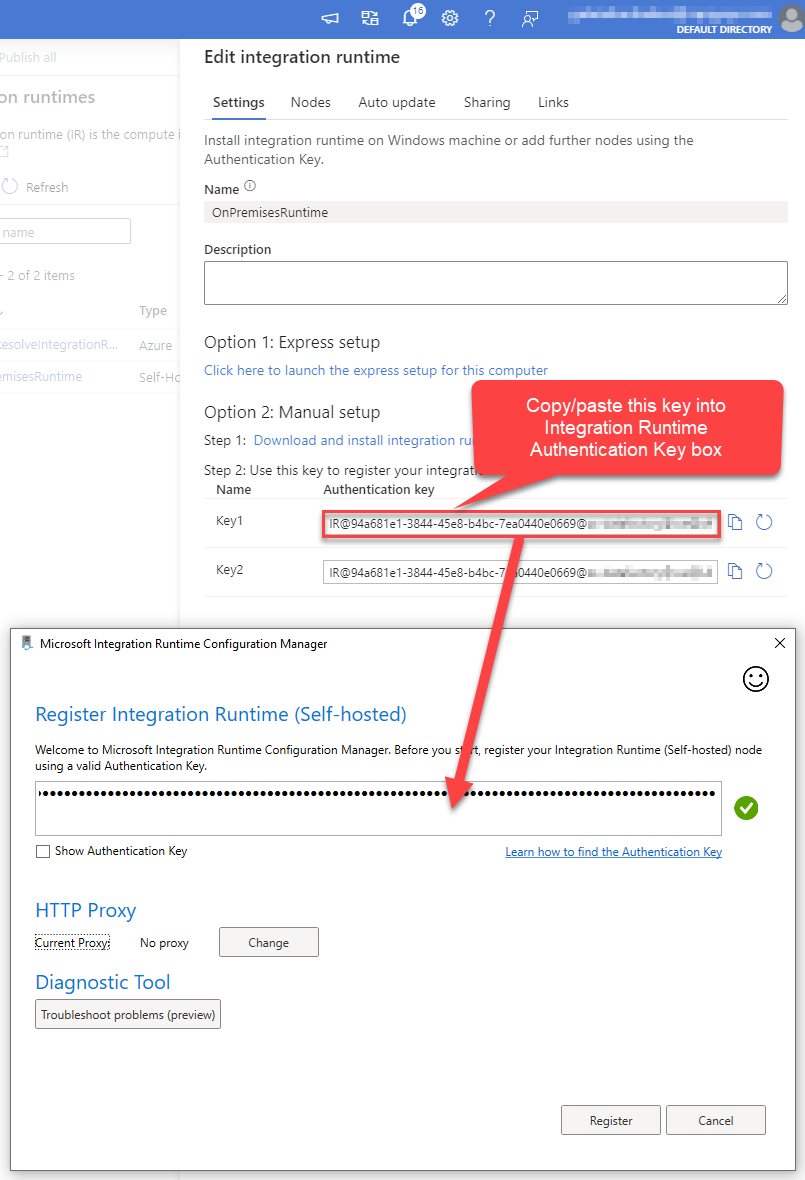
-
After finishing registering the Integration Runtime node, you should see a similar view:
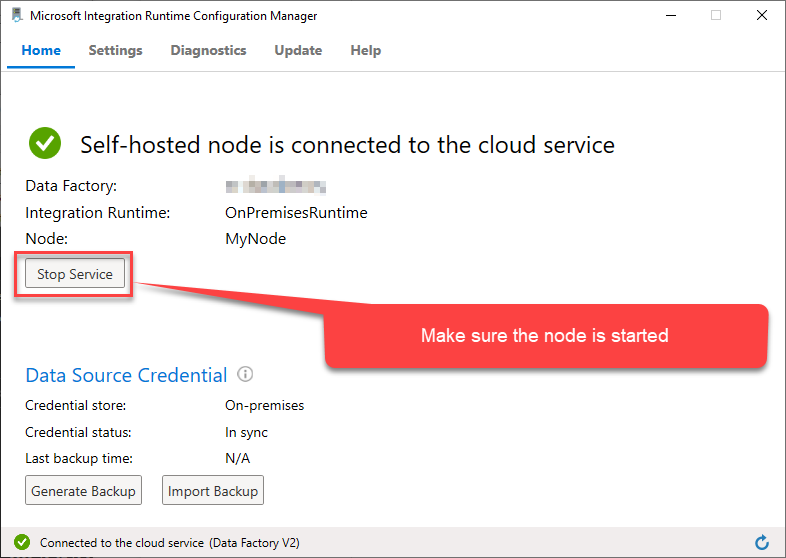
-
Go back to Azure Portal and finish adding new Integration Runtime. You should see it was successfully added:
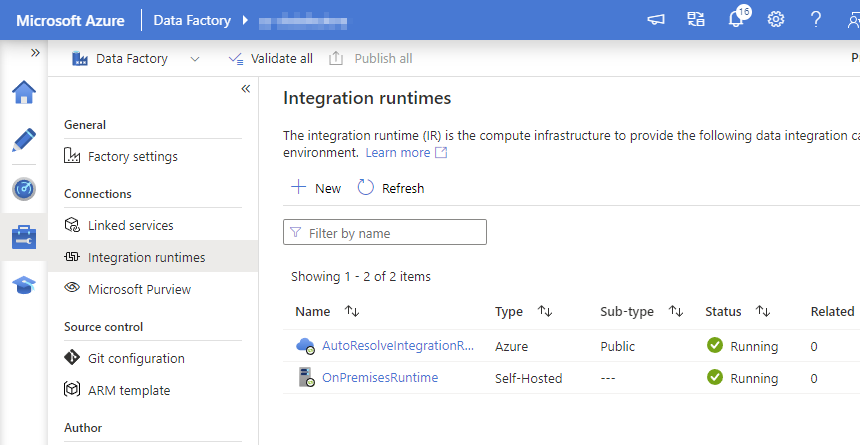
-
Create a New Linked service:
In the Manage section (left menu).
Under Connections, select Linked services.
Click + New to create a new Linked service based on ODBC.
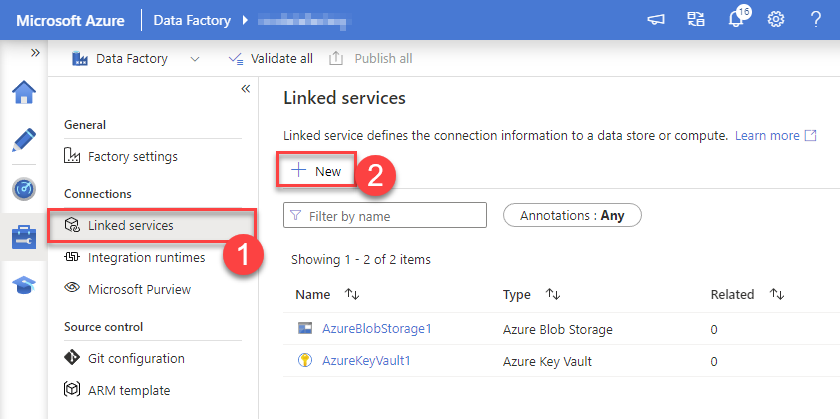
-
Select ODBC service:
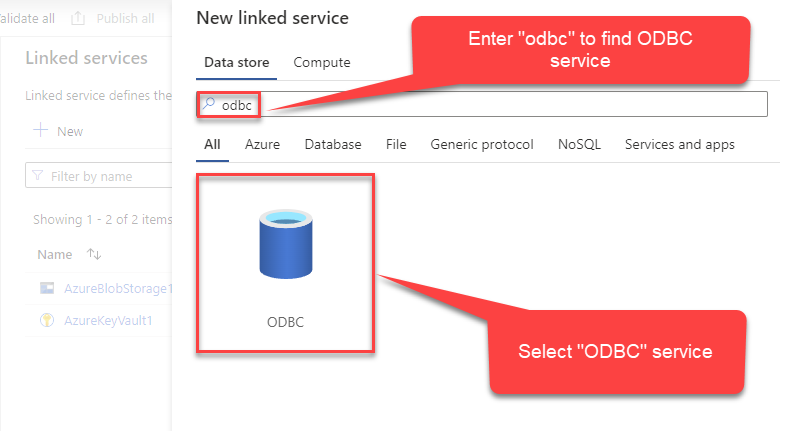
-
Configure new ODBC service. Use the same DSN name we used in the previous step and copy it to Connection string box:
ZoomDSNDSN=ZoomDSN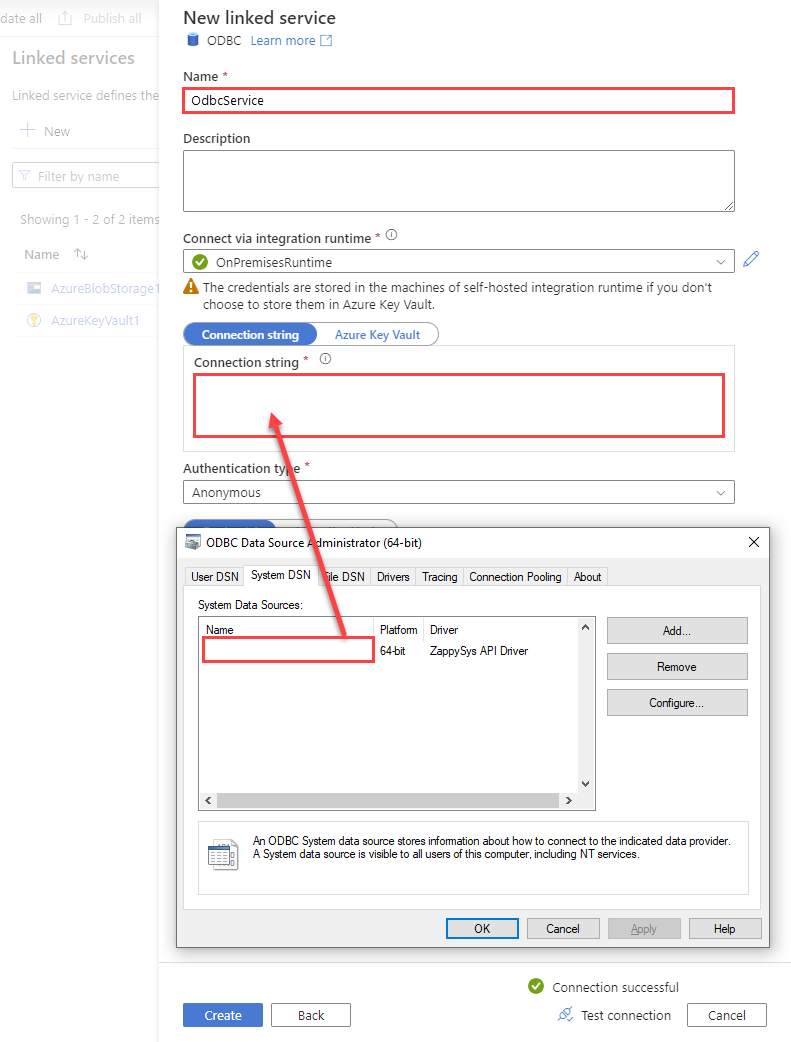
-
For created ODBC service create ODBC-based dataset:
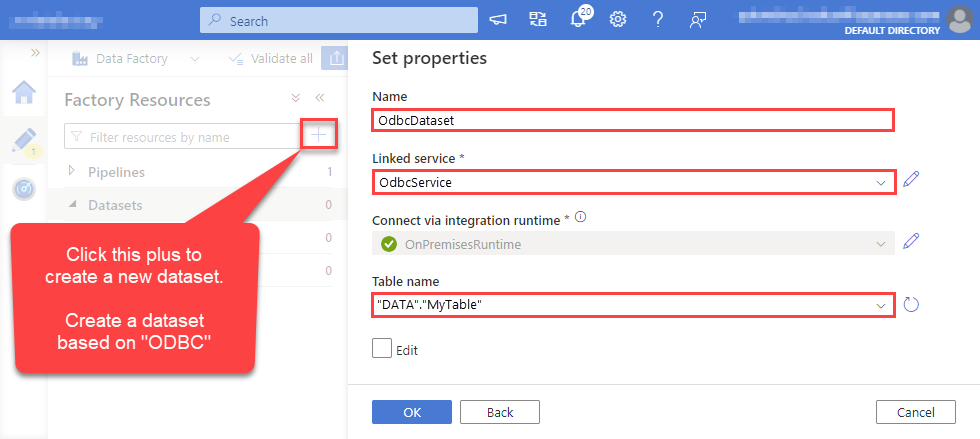
-
Go to your pipeline and add Copy data connector into the flow. In Source section use OdbcDataset we created as a source dataset:
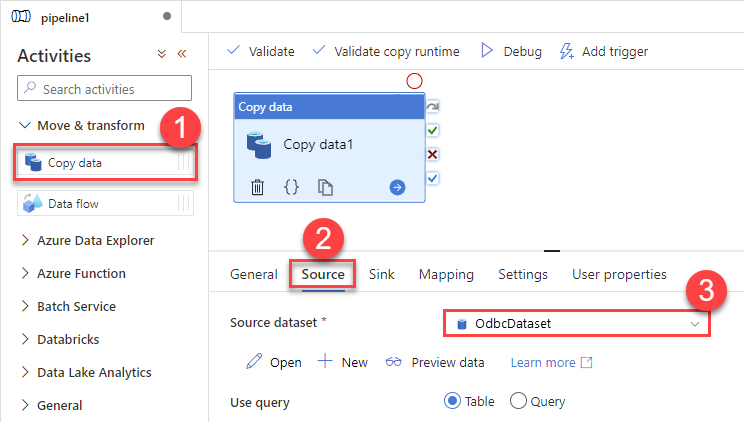
-
Then go to Sink section and select a destination/sink dataset. In this example we use precreated AzureBlobStorageDataset which saves data into an Azure Blob:
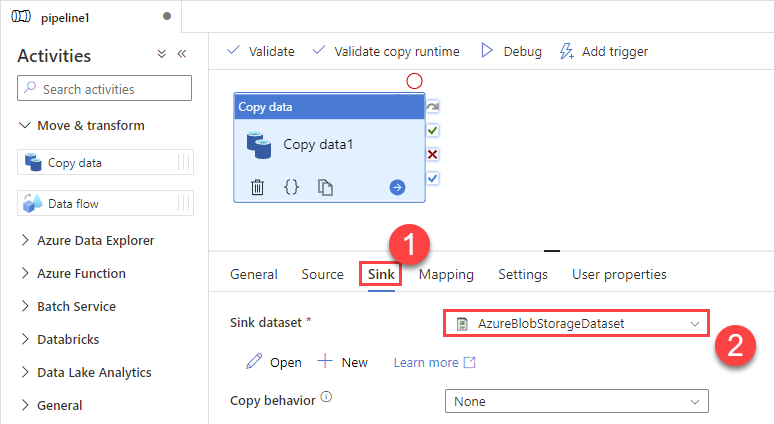
-
Finally, run the pipeline and see data being transferred from OdbcDataset to your destination dataset:
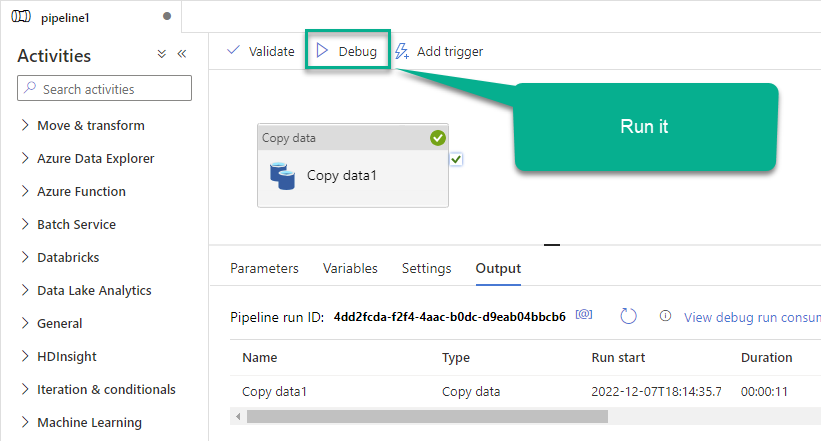
Executing SQL queries using Lookup activity
If you need to execute commands in Zoom instead of retrieving data, use the Lookup activity for that purpose. Use this approach when you want data to be changed on the Zoom side, but you don't need the data on your side (a "fire-and-forget" scenario).
Perform these simple steps to accomplish that:
-
Go to your pipeline in Azure Data Factory
-
Find Lookup activity in the Activities pane
-
Then drag-and-drop the Lookup activity onto your pipeline canvas
-
Click Settings tab
-
Select
OdbcDatasetin the Source dataset field -
Finally, enter your SQL query in the Query text box:

Centralized data access via Data Gateway
In some situations, you may need to provide Zoom data access to multiple users or services. Configuring the data source on a Data Gateway creates a single, centralized connection point for this purpose.
This configuration provides two primary advantages:
-
Centralized data access
The data source is configured once on the gateway, eliminating the need to set it up individually on each user's machine or application. This significantly simplifies the management process.
-
Centralized access control
Since all connections route through the gateway, access can be governed or revoked from a single location for all users.
| Data Gateway |
Local ODBC
data source
|
|
|---|---|---|
| Simple configuration | ||
| Installation | Single machine | Per machine |
| Connectivity | Local and remote | Local only |
| Connections limit | Limited by License | Unlimited |
| Central data access | ||
| Central access control | ||
| More flexible cost |
If you need any of these requirements, you will have to create a data source in Data Gateway to connect to Zoom, and to create an ODBC data source to connect to Data Gateway in Azure Data Factory (Pipeline).
Let's not wait and get going!
Creating Zoom data source in Gateway
In this section we will create a data source for Zoom in Data Gateway. Let's follow these steps to accomplish that:
-
Search for
gatewayin Windows Start Menu and open ZappySys Data Gateway Configuration:
-
Go to Users tab and follow these steps to add a Data Gateway user:
- Click Add button
-
In Login field enter username, e.g.,
john - Then enter a Password
- Check Is Administrator checkbox
- Click OK to save

-
Now we are ready to add a data source:
- Click Add button
- Give Datasource a name (have it handy for later)
- Then select Native - ZappySys API Driver
- Finally, click OK
ZoomDSNZappySys API Driver
-
When the ZappySys API Driver configuration window opens, configure the Data Source the same way you configured it in ODBC Data Sources (64-bit), in the beginning of this article.
-
Very important step. Now, after creating or modifying the data source make sure you:
- Click the Save button to persist your changes.
- Hit Yes, once asked if you want to restart the Data Gateway service.
This will ensure all changes are properly applied:
 Skipping this step may result in the new settings not taking effect and, therefore you will not be able to connect to the data source.
Skipping this step may result in the new settings not taking effect and, therefore you will not be able to connect to the data source.
Creating ODBC data source for Data Gateway
In this part we will create ODBC data source to connect to Data Gateway from Azure Data Factory (Pipeline). To achieve that, let's perform these steps:
-
Open ODBC Data Sources (x64):

-
Create a User data source (User DSN) based on ODBC Driver 17 for SQL Server:
ODBC Driver 17 for SQL Server If you don't see ODBC Driver 17 for SQL Server driver in the list, choose a similar version driver.
If you don't see ODBC Driver 17 for SQL Server driver in the list, choose a similar version driver. -
Then set a Name of the data source (e.g.
Gateway) and the address of the Data Gateway:GatewayDSNlocalhost,5000 Make sure you separate the hostname and port with a comma, e.g.
Make sure you separate the hostname and port with a comma, e.g.localhost,5000. -
Proceed with authentication part:
- Select SQL Server authentication
-
In Login ID field enter the user name you used in Data Gateway, e.g.,
john - Set Password to the one you configured in Data Gateway

-
Then set the default database property to
ZoomDSN(the one we used in Data Gateway):ZoomDSN
-
Continue by checking Trust server certificate option:

-
Once you do that, test the connection:

-
If connection is successful, everything is good:

-
Done!
We are ready to move to the final step. Let's do it!
Accessing data in Azure Data Factory (Pipeline) via Data Gateway
Finally, we are ready to read data from Zoom in Azure Data Factory (Pipeline) via Data Gateway. Follow these final steps:
-
Go back to Azure Data Factory (Pipeline).
-
Create a New Linked service:
In the Manage section (left menu).
Under Connections, select Linked services.
Click + New to create a new Linked service based on ODBC.

-
Select ODBC service:

-
Configure new ODBC service. Use the same DSN name we used in the previous step and copy it to Connection string box:
GatewayDSNDSN=GatewayDSN
-
Read the data the same way we discussed at the beginning of this article.
-
That's it!
Now you can connect to Zoom data in Azure Data Factory (Pipeline) via the Data Gateway.
john and your password.
Actions supported by Zoom Connector
Learn how to perform common Zoom actions directly in Azure Data Factory (Pipeline) with these how-to guides:
- GET Current User (Me)
- Get Meeting By Id
- GET Settings
- Get Webinar Settings
- Get Webinar Settings By Id
- List Meeting Registrants
- List Meetings
- List Meetings (All Users)
- List Past Meetings (All Users)
- List Registration Questions
- List Users
- List Webinar Registrants
- List Webinars
- Past Meeting
- Make Generic API Request
- Make Generic API Request (Bulk Write)
Conclusion
In this article we showed you how to connect to Zoom in Azure Data Factory (Pipeline) and integrate data without any coding, saving you time and effort.
We encourage you to download Zoom Connector for Azure Data Factory (Pipeline) and see how easy it is to use it for yourself or your team.
If you have any questions, feel free to contact ZappySys support team. You can also open a live chat immediately by clicking on the chat icon below.
Download Zoom Connector for Azure Data Factory (Pipeline) Documentation











































































